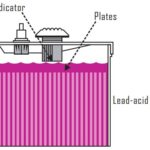Car scratches and paint chips are an unfortunate reality for car owners. In the quest for a quick and affordable fix, auto scratch repair pens often emerge as a seemingly convenient solution. You might have seen these pens at auto parts stores or dealerships, promising to magically erase those unsightly blemishes. But do these scratch repair pens truly live up to the hype? As content creators at Car Repair Online and experts in auto body repair, we’re here to give you an honest assessment based on years of experience in the field.
The truth is, while auto scratch repair pens might seem like a simple DIY fix, they often fall short of delivering satisfactory results. In many cases, they can even make the damage look worse. We’ve spent countless hours correcting the less-than-perfect outcomes of these pens, particularly at car dealerships where attempts to conceal lease return damage are common. Instead of achieving a seamless repair, these pens frequently leave behind noticeable paint blobs and uneven finishes.
The Problem with Auto Scratch Repair Pens
The fundamental issue with most auto scratch repair pens lies in their design and application. These pens typically dispense a thick, single-stage paint that is intended to fill the scratch. However, several factors contribute to their ineffectiveness:
- Paint Blobbing: The most common problem is the tendency of these pens to deposit excessive paint, creating raised blobs that are far more conspicuous than the original scratch. This uneven application is difficult to avoid due to the pen’s tip design and the viscosity of the paint.
- Color Mismatch: Achieving a perfect color match with a pen is challenging. Even with color codes, the touch-up paint may not precisely match the aged and potentially faded paint on your car. This discrepancy becomes even more noticeable in direct sunlight.
- Difficult Application: Applying the paint evenly within the scratch without getting excess paint on the surrounding good paint is tricky, especially for those without auto painting experience.
- Durability Concerns: The paint from these pens is often not as durable as factory car paint and may be more susceptible to peeling or fading over time.
It’s important to understand that for dealerships and car manufacturers, touch-up paint pens serve primarily as an additional revenue stream. While they may offer a semblance of a quick fix, the aesthetic outcome for your car is often not their primary concern.
When Do Touch-Up Paint Pens Fail?
While marketing might suggest these pens are a cure-all for scratches, their limitations become apparent in various scenarios:
- Deep Scratches: For scratches that penetrate beyond the clear coat and into the base coat or primer, a simple pen is inadequate. It might fill the scratch with paint, but it won’t address the underlying damage or restore the multiple layers of paint.
- Large Areas of Damage: Scratch repair pens are designed for very small, isolated scratches or chips. Attempting to use them on larger scratched areas will inevitably lead to uneven coverage and a visibly poor repair.
- Metallic and Pearl Paints: These types of paints are complex, involving multiple layers and specific application techniques to achieve their unique shimmer and depth. Touch-up pens typically contain a single-stage paint that cannot replicate the nuances of metallic or pearl finishes, resulting in a noticeable mismatch.
Are There Any Alternatives?
Fortunately, if you’re looking for a genuinely effective solution for minor car paint damage, there are better alternatives to standard scratch repair pens.
One product that stands out and that we recommend is Dr. Colorchip. Unlike typical pens, Dr. Colorchip utilizes a two-step process involving a precisely matched paint and a blending solution. This system allows for a much smoother and more seamless repair, effectively minimizing paint blobs and blending the touch-up paint with the surrounding factory finish. In our experience, Dr. Colorchip is the only DIY touch-up system that consistently delivers professional-looking results.
For more significant scratches or if you prefer professional-grade results, seeking the services of a qualified auto paint repair specialist is always the best option. Professionals have the expertise, tools, and materials to properly assess the damage, prepare the area, and apply paint for a flawless and long-lasting repair.
How to Fix Mistakes from Touch-Up Pens
If you’ve already used a scratch repair pen and are unhappy with the results, especially the dreaded paint blobs, there’s a way to rectify the situation. Drawing from our experience in correcting touch-up pen mishaps, here’s a method you can try:
To remove paint blobs from touch-up pens, you can use a blending solution, ideally like the “pink juice” included in Dr. Colorchip kits. If you don’t have that specific solution, proceed with caution using acetone.
- Blending Solution (Preferred): Apply a few drops of blending solution to a folded cotton t-shirt cloth. Gently rub the paint blobs. Frequently wipe away residue with a clean microfiber towel as you work.
- Acetone (Use with Caution): If you don’t have blending solution, acetone can be used, but with extreme care. Apply a very small amount to a cloth, gently rub the blob, and immediately wipe it off every few seconds. Acetone is a strong solvent and can damage your car’s clear coat and paint if left on too long or used aggressively, especially on darker colored cars. If the finish becomes dull from acetone, use a soft cloth and rubbing compound to buff the area back to shine.
Important Note: Never use stronger solvents than acetone as they will undoubtedly damage your car’s clear coat.
Conclusion
While the allure of a quick fix with auto scratch repair pens is understandable, their actual performance often leaves much to be desired. For minor, superficial scratches, they might offer a temporary cosmetic improvement from afar, but close inspection usually reveals uneven paint and noticeable touch-ups. For deeper scratches, larger areas, or cars with metallic/pearl paints, scratch repair pens are generally ineffective and can even worsen the appearance.
For those seeking a genuinely effective DIY solution, consider exploring systems like Dr. Colorchip, which offer a more refined approach to paint touch-ups. And for optimal, long-lasting results, professional auto paint repair services remain the gold standard. Investing in quality repair methods will ultimately preserve your car’s appearance and value far better than relying on the often-disappointing results of auto scratch repair pens.


